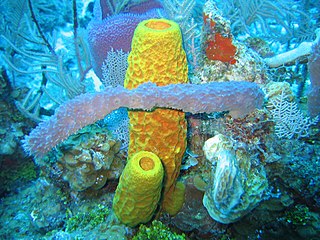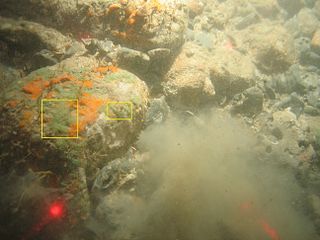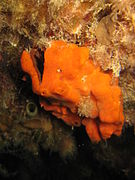
Demosponges (Demospongiae) are the most diverse class in the phylum Porifera. They include greater than 90% of all species of sponges with nearly 8,800 species worldwide. They are sponges with a soft body that covers a hard, often massive skeleton made of calcium carbonate, either aragonite or calcite. They are predominantly leuconoid in structure. Their "skeletons" are made of spicules consisting of fibers of the protein spongin, the mineral silica, or both. Where spicules of silica are present, they have a different shape from those in the otherwise similar glass sponges. Some species, in particular from the Antarctic, obtain the silica for spicule building from the ingestion of siliceous diatoms.

Chondrocladia is a genus of carnivorous demosponges of the family Cladorhizidae. Neocladia was long considered a junior synonym, but recently become accepted as a distinct genus.

Eduard Oscar Schmidt was a German zoologist and phycologist.

Poecilosclerida is an order of the demosponge class. It is the most speciose demosponge order with over 2200 species. It contains about 25 recognised families. They are characterised by having chelae microscleres, that is, the minute spicules scattered through the tissues, usually in the 10-60 μm range, have a shovel-like structure on the end.

Crambeidae is a family of marine demosponges.

Ancorinidae is a family of marine sponges belonging to the order of Tetractinellida.

Dictyoceratida is an order of sponges in the subclass Ceractinomorpha containing five families. Along with the Dendroceratida, it is one of the two orders of demosponges that make up the keratose or "horny" sponges, in which a mineral skeleton is minimal or absent and a skeleton of organic fibers containing spongin, a collagen-like material, is present instead.
Crella elegans is a species of marine demosponges in the family Crellidae found in the Adriatic. It is the type species of its genus. It is the host of the ectoparasitic copepod Cryptopontius capitalis.

Thorectidae is a family of sea sponges in the order Dictyoceratida.

Hymedesmiidae is a family of demosponges in the order Poecilosclerida.
Merliida is an order of demosponges in the subclass Heteroscleromorpha, first described as such by Jean Vacelet in 1979.
Amphoriscus is a genus of calcareous sponges in the family Amphoriscidae.

Geodia megastrella is a species of sponge in the family Geodiidae. It is a type of demosponge found in the deep temperate waters of the North Atlantic Ocean. It has characteristic stellar-shaped large spicules coined 'megastrellum', hence its name. The species was first described by Henry John Carter in 1876, after dredging it up aboard H.M.S. 'Porcupine', near the Cape St. Vincent in Portugal.
Geodia conchilega is a species of sea sponge in the family Geodiidae.
Jean Vacelet is a French marine biologist who specialises in the underwater fauna of the Mediterranean. After earning his licence at the Faculté des Sciences de Marseille and learning to dive in 1954, he specialised in the study of sponges at the Marine station of Endoume, and there he has stayed faithful to both sponges and place for more than half a century. His research has included all aspects of sponges: taxonomy, habitat, biology, anatomy, their bacterial associations, and their place in the evolution of multi-celled animals. He has studied them not only in the Mediterranean but in the Indian Ocean and the Pacific. Exploration of underwater grottoes, together with Jacques Laborel and Jo Hamelin, revealed the existence of sponges dating from very ancient geological periods and the unexpected existence of carnivorous sponges, and surprisingly, the grottoes in some ways mimicked life at much greater depths.

Halisarcidae is a family of sea sponges within the order Chondrillida. Members of the family are characterised by having long tubular, branched choanocyte chambers; they have no spicules which makes it difficult to determine the group's affinities with other sponge families. Halisarcidae is a monogeneric family, the only genus being Halisarca.
Corticium is a genus of sponges in the order Homosclerophorida first described by Eduard Oscar Schmidt in 1862.

Robertus Wilhelmus Maria (Rob) van Soest, born in 1946, is a Dutch marine biologist. He works at the Naturalis Biodiversity Center and is also affiliated with the University of Amsterdam. He co-authored with John N. A. Hooper Systema Porifera: A Guide to the Classification of Sponges, a standard reference for sponge classification.

Monanchora is a genus of demosponges belonging to the family Crambeida. The genus contains 18 species, which have been researched for their potential use in medicine.

Oscarella is a genus of marine sponges. The genus can be found off the coast of every continent, in every ocean except the Arctic.

















